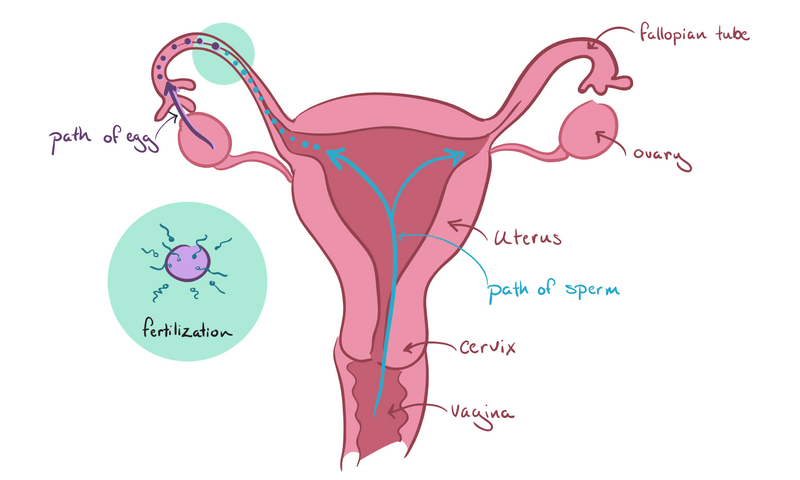A better-than-sex-ed refresh of what’s what with the female side of the equation
So you want to start a family – congratulations, you dad-to-be! If you’re anything like us, you’ve lived your whole sexual life assuming that it’s easy to get a woman pregnant. But when you get down to it, getting pregnant can actually be...sort of hard. Take a minute and let that sink in. We’ve been told our whole lives that our swimmers can find an egg at the drop of a hat. And sometimes they can. But…sometimes they can’t. And in the background of trying to conceive is a complex process that needs to work in perfect harmony for you to get that perfect baby.
In this article (part 1 of a series!) we’ll go through the female side of fertility – all of the nuts and bolts of periods, ovulation, and fertilization so you can feel empowered to understand the entire conception process. After all, you’re 50% of the equation and she can’t do it without you – so let’s study up.
Before we begin, a quick note: throughout this article we’ll be talking about partners, couples, and trying to conceive with a focus on heterosexual couples (a one penis, one vagina lens). We’ll be publishing more articles on trying to conceive for LGBTQ+ folks soon!
One final note: we’re about to get pretty science-y here, so let’s nerd out. Not so interested in the nitty gritty details of women’s reproductive health? Skip ahead to Part 2 of this article for more info on the ~emotional~ side of conception.
A uterus, a follicle, and an ovary walk into a bar…
We don’t have a punchline to that joke but did it hook you? Nice, it hooked you. Now that you’re here, we’ll do a quick refresh on what’s going on with the female reproductive system.
Let’s travel up through the vagina and explore the cervix and the uterus. The cervix divides a woman’s vagina from her uterus. When you pass through the cervix you reach the uterus – the place where a fetus will eventually grow into a baby. The cervix controls the flow of sperm up through the vagina into the uterus, and the flow of menstrual blood down through the cervix into the vagina. On either side of the uterus you can find the ovaries, connected to the uterus through the fallopian tubes. Every month, a new cycle of eggs mature in the ovaries, and one or two of them are released during a woman’s menstrual cycle. After an egg has matured, it travels down through the fallopian tubes. If an egg meets a sperm in the fallopian tubes within 24 hours of ovulation, it can become fertilized and eventually travel into the uterus for implantation.
Image credit: Khan Academy
For a successful pregnancy to occur the physical setup here needs to be working perfectly. Issues can range from blockages in the fallopian tubes that prevent an egg from reaching the uterus (which can be caused by STIs like untreated gonorrhea or chlamydia) to issues with the uterine lining (caused by conditions like endometriosis).1
The female reproductive system is the physical home of where pregnancy will take place. To understand how all of this works, though, we need to understand hormones. And for that, we need to understand periods.
Periods: way more than just pads and tampons
Depending on the number of sisters you grew up with, periods may be very familiar to you, or very confusing. Every month between puberty and menopause, a woman’s body prepares for the possibility of pregnancy by maturing and releasing an egg, and creating a comfortable home in the uterus for that egg to implant. If all goes to plan and the mature egg meets a sperm (“fertilization”), a pregnancy may happen. If fertilization does not occur, the unfertilized egg dissolves and passes through the cervix into the vagina, along with the lining of the uterus. This shedding is called menstruation – “having your period” means that you are passing the lining of the uterus out through the vagina. Common menstrual symptoms include cramps (grab her a hot water bottle!), bloating, sore or swollen breasts, and mood swings.
A quick note on eggs: women are born with all the eggs they will ever have (this is very different from men, who constantly are creating new sperm!). The average woman has about one million eggs when she starts puberty. By the time a woman hits menopause – age 51, on average, in the United States – she has lost every single one of those eggs.2 One or two eggs are shed every month through the menstrual cycle but approximately 1,000 more are lost in the background every month. Why? This is, effectively, a selection mechanism that a woman’s body is performing – only the best eggs get chosen to mature.
So now we know what happens when a woman gets her period. But what’s happening the rest of the month?
Every month, a woman’s body prepares for pregnancy in four distinct phases: the follicular phase, ovulation, the luteal phase, and menstruation. Each of these phases are triggered and run by different suites of hormones. Each phase has a different purpose, but they all build up to preparing a woman’s body for pregnancy and for that most important moment – when an egg meets a sperm.
Follicular Phase. The Follicular Phase starts on the first day of a woman’s period, when signals in the brain tell the ovaries to start maturing a new batch of eggs. Follicle Stimulating Hormone (FSH) and Luteinizing Hormone (LH) travel from the brain to the ovaries and trigger approximately 15-20 eggs to start maturing (remember, all of the eggs a woman has are waiting in the ovaries until they get their shot at maturation). For approximately 2 weeks the eggs will mature. During this time one egg (which is contained in a follicle) will become the lead follicle. When the body has decided on a lead follicle (the lead follicle is generally the healthiest egg) the rest of the eggs stop growing. This allows the body to concentrate on making the lead follicle the best possible egg it can be.3
Ovulation. When the lead follicle reaches approx. 20 mm (that’s about the size of a grape!) a surge of LH will trigger the ovaries to release the egg into the fallopian tube.4 This generally happens about halfway through a woman’s cycle (approx. 14 days before her next period). The egg will then wait in the fallopian tubes for approximately 24 hours. If a sperm meets up with the egg during this time, fertilization may occur. If the egg is not fertilized within 24 hours, it will dissolve. It’s important to remember here that sperm can live in a woman’s body for up to 5 days – so any unprotected sex during the 5 days prior to ovulation may result in a fertilized egg.5
#spermstat: Did you know that it can take healthy sperm just a few minutes to reach the fallopian tubes after ejaculation?6
Luteal Phase. Right after ovulation occurs the ovaries start producing Progesterone, a hormone that helps the lining of the uterus thicken. This thickened uterine lining will provide a nourishing home for a fertilized egg to implant and develop. After an egg is fertilized, it undergoes 3-4 days of rapid cell division to become a blastocyst; during this process the egg is also slowly moving down the fallopian tube.7 After leaving the fallopian tube, the blastocyst will try to implant in the thickened uterine lining. If implantation is successful, the fertilized egg may go on to develop into a healthy pregnancy. However, 50% of all fertilized eggs are not able to develop to the blastocyst phase or to implant successfully.8
Once an egg successfully implants into the uterine lining (which can take approx. 2-3 days after reaching the uterus) a woman is considered “pregnant”.9 A successfully implanted fertilized egg will prompt a woman’s body to start releasing hormones that prevent the shedding of the uterus – which is why not getting a period is one of the first signs of pregnancy.
Menstruation. If the ovulated egg does not meet a sperm in time, or if the fertilized egg fails to implant successfully, the lining of the uterus will be shed and a woman will start her period.
Timing is everything
Clearly, this is a more complicated process than what we’re taught in sex-ed. To have a successful pregnancy from the female side, a woman’s hormones need to be working perfectly, there can be no physical blockages that prevent an egg traveling from the fallopian tubes into the uterus, no issues with the uterine lining, and her egg quality needs to be high. From the male side, sperm need to be healthy enough to reach the fallopian tubes and strong enough to penetrate the egg for fertilization. When you add in the fact that all of this needs to happen during 6 specific days, it can feel like a surprise that anyone ever manages to get pregnant at all. Our bodies are powerful systems – and knowing how it all works together is even more powerful.
Next up in this series we’ll dive into topics to keep in mind when you’re actively trying to conceive – cycle tracking, things that may go wrong, how stress can affect all of this, and information on trying to conceive timelines and resources. Read on here and in the meantime, go impress your partner by dropping some serious knowledge.
The information we provide does not constitute medical advice. You should make all reproductive health decisions with a medical professional.
It would be nigh impossible to find a bunch more passionate about fertility than the Fellow Team. We are a group of colleagues who loves to author articles in our free time (that is, when we aren't challenging each other to games of Code Names). You can reach us at marketing@meetfellow.com.

